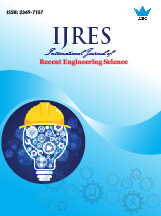An Area Efficient Denoising Architecture Using Adaptive Rank Order Filter
 |
International Journal of Recent Engineering Science (IJRES) |  |
| © 2014 by IJRES Journal | ||
| Volume-1 Issue-4 |
||
| Year of Publication : 2014 | ||
| Authors : N.Sathya |
||
| DOI : 10.14445/23497157/IJRES-V1I4P103 |
How to Cite?
N.Sathya , "An Area Efficient Denoising Architecture Using Adaptive Rank Order Filter," International Journal of Recent Engineering Science, vol. 1, no. 4, pp. 11-14, 2014. Crossref, https://doi.org/10.14445/23497157/IJRES-V1I4P103
Abstract
Noises are occurs in an images during the process of acquisition and transmission. Image denoising is a process of removing noises from an corrupted images while preserving the details of an image. In existing an decision tree based denoising scheme (DTBDM) and its VLSI architecture is used to remove the impulse noise. The DTBDM consists of two components such as decision-tree-based impulse detector and edge-preserving image filter,these two components are used to detect and remove the noise in an image but this architecture consumes large area.Adaptive rank order filter architecture is proposed to remove the noises and also to reduce area of an architecture.
Keywords
Adaptive rank order filter, DTBDM, Image denoising, VLSI architecture
Reference
[1] R.C. Gonzalez and R.E. Woods, Digital Image Processing. Pearson Education, 2007.
[2] W.K. Pratt, Digital Image Processing. Wiley-Interscience, 1991.
[3] H. Hwang and R.A. Haddad, “Adaptive Median Filters: NewAlgorithms and Results,” IEEE Trans. Image Processing, vol. 4, no. 4, pp. 499-502, Apr. 1995.
[4] S. Zhang and M.A. Karim, “A New Impulse Detector for Switching Median Filter,” IEEE Signal Processing Letters, vol. 9, no. 11, pp. 360-363, Nov. 2002.
[5] R.H. Chan, C.W. Ho, and M. Nikolova, “Salt-and-Pepper NoiseRemoval by Median-Type Noise Detectors and DetailPreservingRegularization,” IEEE Trans. Image Processing, vol. 14, no. 10, pp. 1479-1485, Oct. 2005
[6] P.E. Ng and K.K. Ma, “A Switching Median Filter with Boundary Discriminative Noise Detection for Extremely Corrupted Images,” IEEE Trans. Image Processing, vol. 15, no. 6, pp. 1506- 1516, June 2006.
[7] P.-Y. Chen and C.-Y.Lien, “An Efficient EdgePreservingAlgorithm for Removal of Salt-and-Pepper Noise,” IEEE SignalProcessing Letters, vol. 15, pp. 833-836, Dec. 2008.
[8] T. Nodes and N. Gallagher, “Median Filters: Some Modifications and Their Properties,” IEEE Trans. Acoustics, Speech, Signal Processing, vol. ASSP-30, no. 5, pp. 739-746, Oct. 1982.
[9] S.-J. Ko and Y.-H. Lee, “Center Weighted Median Filters and Their Applications to Image Enhancement,” IEEE Trans. CircuitsSystems, vol. 38, no. 9, pp. 984-993, Sept. 1991.
[10] T. Sun and Y. Neuvo, “Detail-Preserving Median Based Filters in Image Processing,” Pattern Recognition Letters, vol. 15, pp. 341-347, Apr. 1994.
[11] E. Abreu, M. Lightstone, S.K. Mitra, and K. Arakawa, “A New Efficient Approach for the Removal of Impulse Noise from Highly Corrupted Images,” IEEE Trans. Image Processing, vol. 5, no. 6, pp. 1012-1025, June 1996.
[12] T. Chen and H.R. Wu, “Adaptive Impulse Detection UsingCenter-Weighted Median Filters,” IEEE Signal Processing Letters, vol. 8, no. 1, pp. 1-3, Jan. 2001
[13] T. Chen and H.R. Wu, “Space Variant Median Filters for theRestoration of Impulse Noise Corrupted Images,” IEEE Trans.Circuits Systems II, Analog Digital Signal Processing, vol. 48, no. 8, pp. 784-789, Aug. 2001.
[14] W. Luo, “An Efficient Detail-Preserving Approach for Removing Impulse Noise in Images,” IEEE Signal Processing Letters, vol. 13, no. 7, pp. 413-416, July 2006.
[15] I. Aizenberg and C. Butakoff, “Effective Impulse Detector Based on Rank-Order Criteria,” IEEE Signal Processing Letters, vol. 11, no. 3, pp. 363-366, Mar. 2004.
[16] H. Yu, L. Zhao, and H. Wang, “An Efficient Procedure forRemoving Random-Valued Impulse Noise in Images,” IEEE SignalProcessing Letters, vol. 15, pp. 922-925, 2008.
[17] Y. Dong and S. Xu, “A New Directional Weighted Median Filter for Removal of Random-Valued Impulse Noise,” IEEE Signal Processing Letters, vol. 14, no. 3, pp. 193-196, Mar. 2007.
[18] N.I. Petrovic and V. Crnojevic, “Universal Impulse Noise Filter Based on Genetic Programming,” IEEE Trans. Image Processing, vol. 17, no. 7, pp. 1109-1120, July 2008.
[19] B. De Ville, Decision Trees for Business Intelligence and Data Mining. SAS Publishing, 2007.
[20] S. RasoulSafavian and D. Landgrebe, “A Survey of Decision Tree Classifier Methodology,” IEEE Trans. Systems Man, Cybernetics, vol. 21, no. 3, pp 660-674, May 1991
[21] H.-H. Tsai, X.-P.Lin, and B.-M. Chang, “An Image Filter with a Hybrid Impulse Detector Based on Decision Tree and Particle Swarm Optimization,” Proc. IEEE Int’l Conf. Machine Learning and Cybernetics, July 2009.
[22] H.-L. Eng and K.-K. Ma, “Noise Adaptive Soft-Switching Median Filter,” IEEE Trans. Image Processing, vol. 10, no. 2, pp. 242-251, Feb. 2001
[23] G. Pok, J. Liu, and A.S. Nair, “Selective Removal of Impulse Noise Based on Homogeneity Level Information,” IEEE Trans. Image Processing, vol. 12, no. 1, pp. 85-92, Jan. 2003.
